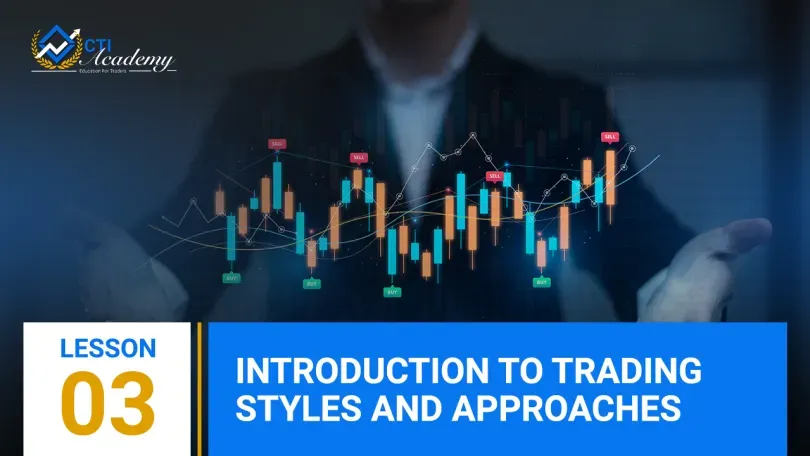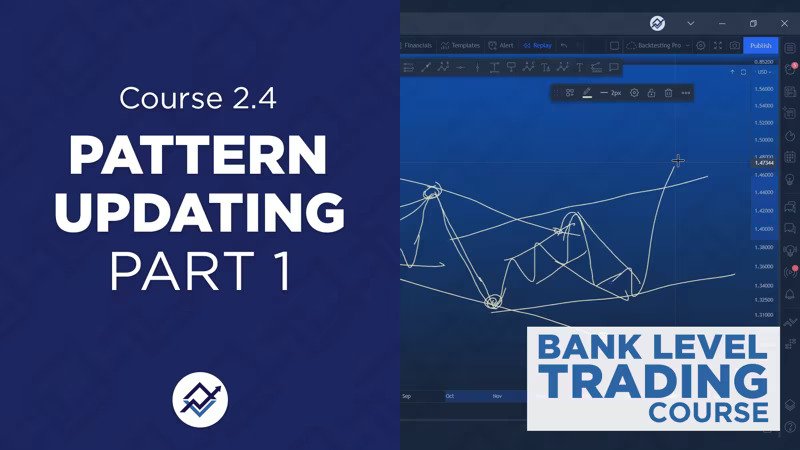Introduction - Lesson 3: Introduction to Trading Styles and Approaches
The art of trading in the financial markets is rich and varied, encompassing numerous styles and approaches. Understanding these is fundamental to achieving success in trading. This article will explore the main trading styles – day trading, swing trading, position trading, and others, while also addressing the most common questions related to trading strategies.
The Spectrum of Trading Styles
Trading styles range from day trading, known for its rapid pace and focus on intraday movements, to position trading, which takes a longer-term approach based on fundamental analysis. Swing trading sits in between, capturing short- to medium-term market moves.
Frequently Asked Questions
What are the 4 types of trading strategies?
Trading strategies typically include day trading, position trading, swing trading, and scalping. After 24 years, it has become clear to me that the choice of strategy depends on personality. In my opinion, you should explore all of them to understand the benefits each provides. Personally, I have traded using all four strategies.
Currently, I prefer long positions in stocks and crypto companies that I believe will perform better than inflation. This approach suits a passive investor, but I am not a passive investor because I seek more active gains. That’s why swing trading, or speculation, is important to me. Additionally, why not engage in day trading if my positions are moving in my desired direction? Combining all these strategies makes me the professional trader I am today.
Do you need to use all these strategies? No, but I do recommend learning about them all. Start by trading on a demo account or with a small account to experience the wins, losses, and the stress of day trading. Learn how to manage emotions and decisions, whether to hold or sell, and experience the anxiety of checking your stocks only once a year. This will teach you much about yourself and your trading style.
Other block related:
What are the 6 types of trades?
Beyond the main trading styles, there are other approaches such as momentum trading, algorithmic trading, and arbitrage. Drawing from my own experience, I’ve explored algorithmic trading by creating numerous tools and ideas. Although I’ve never developed a tool that works indefinitely, I have found tools that help reduce my emotional reactions and offer new perspectives. For instance, if you can identify a consistent entry point, it’s possible to code this into an algorithm. However, tools are data-dependent, and data can vary significantly from one broker to another, or from one liquidity provider to another, making it challenging to consistently stay on top of an algorithm so that it works effectively for you.
As for arbitrage, it can be profitable but comes with its own psychological challenges. Despite its potential, handling the stress and decision-making in arbitrage can be daunting.
In summary, my experiences with these trading approaches have taught me the importance of continuous learning and testing. It’s crucial to keep progressing and experimenting to discover what truly works for you.
How many trading styles are there?
While there are numerous sub-styles, they generally fall under the broader categories of day, swing, and position trading.
Matching Trading Styles with Personal Goals
It’s vital to align one’s trading style with personal goals, risk tolerance, and lifestyle. Each style requires different levels of engagement and risk.
More Questions Answered
What is my trade style?
Your trade style should align with your personal goals, available time, and risk tolerance.
Which trading style is most profitable?
Profitability depends on the trader’s skill, market conditions, and how well the style aligns with their personality and circumstances.
What are the two main types of trading?
The two main types are often considered to be day trading and position trading, with different time frames and strategies.
Adaptive Trading: A Holistic Approach
Adapting to market conditions by adjusting trading strategies is crucial for sustained success. However, recognizing when the market has changed can be challenging. This uncertainty raises a critical question: What do you do when you cannot trade effectively due to market conditions? No trading means no income, and without income, it’s difficult to meet financial obligations.
For me, the key has been to ensure financial stability for the future. This means being prepared to adapt to new market conditions over time, which might require having multiple strategies or sometimes, simply waiting out unfavorable conditions for many months. My approach involves planning financially for the future. I calculate my future financial needs by factoring in an annual inflation rate of 3%. I estimate how much money I will need each January for the next ten years. Whenever I earn more than expected, I save towards this future requirement. This strategy ensures that I am financially prepared for times when I cannot trade actively.
Therefore, I treat trading like a business—no trading, no income. It’s essential to have a plan that allows for financial security, giving you the space to adapt your trading strategies without immediate financial pressure.
The Importance of a Personal Trading Plan
A trading plan is critical. It outlines goals, risk levels, and strategies, acting as a roadmap through market complexities.
Conclusion
This exploration into ‘Trading Styles and Approaches’ lays a foundational knowledge that benefits everyone in the financial markets, from novices to seasoned traders. Understanding and aligning different trading styles with your personal goals is crucial for successful trading. My final takeaway is that testing all styles is invaluable. It helps you understand yourself better and discover what you are truly capable of in trading
Additional Insights
What is the best trading strategy in 2024?
The effectiveness of a trading strategy in 20XX heavily relies on staying attuned to current market trends, advancements in technology, and a trader’s ability to adapt. The best strategy often involves aligning with the direction of macroeconomic factors. Significant events such as COVID-19, wars, economic depressions, and major elections can dramatically influence market directions. For instance, observing how the market reacts to these events can provide valuable insights.
The reason to focus on macroeconomic directions is that large institutions tend to set the market trends—not individual traders, who, regardless of having millions to invest, are too small to sway the market direction significantly by themselves. Take, for example, the ongoing conflict between Ukraine and Russia. The market will likely follow the developments of this war, and a shift could occur only once the conflict ends or if there’s a significant change in the situation.
Therefore, it’s crucial for traders to keep a close watch on macroeconomic trends and follow where the money is flowing. This approach not only aligns with how major market players operate but also maximizes the potential for strategic, informed trading decisions.
What is the easiest trading strategy to learn?
Often, simple trend following strategies are touted as the easiest for beginners. However, this is a misconception. While many professional traders make a living from these strategies, it’s important to recognize that they are not necessarily straightforward for beginners. The main reason why cryptocurrencies and stocks seem easier to work with in the long run is historical; over the last 150 years, there has been a 75% tendency to ‘go long’ and follow upward trends. Despite this, the occasional downturns and market chaos in recent years, compared to centuries of trend following, illustrate that these strategies are not simple.
For beginners, adopting trend following strategies does require understanding specific skills like knowing where to enter trades, when to take profits, and how to recognize when a trend has ended. Yes, trend following can be a good starting point for beginners, but be cautious. The potential to see profits quickly can lead newcomers to falsely believe they have mastered trading.
My recommendation for those considering this path is to always trade within your means. Never risk more than you can afford to lose. Experiencing significant gains can lead to greed and overconfidence, which might tempt you to risk more than is prudent. In the event of losses, this cycle can intensify. Therefore, focus on the trading process, and consistently question whether you are following rules or merely acting on emotion. This discipline is key to long-term success in trading.
What is the golden rule of trading?
The golden rule of trading is to always manage risk and never risk more than you can afford to lose. But how do we determine what amount we can afford to lose? This is a complex question that requires ongoing reflection throughout your trading career. Your financial situation can change; sometimes you may have surplus funds, while at other times you might be tight on money. Sometimes you might feel the need to earn more, and sometimes you might not be as concerned about making money.
A practical way to work how much you can risk is to imagine the worst-case scenario: consider how you would feel if you lost all the money you plan to risk, and even consider a scenario where you lose multiple times your initial capital. If the thought of such a loss causes you significant pain, then the amount you’re considering risking is too much. On the other hand, if the loss doesn’t affect you emotionally, it might be too little. The ideal amount is one that causes a slight discomfort—enough to ensure you are cautious and remain in control.
Moreover, consider the opposite scenario: how would you react if your investment returns ten times your initial stake? If excitement and greed overtake your decision-making process, this could lead to reckless behavior in the future. It’s essential not only to focus on potential gains but also to continuously assess the risks involved. Ask yourself how you would handle the situation if your confidence led to larger risks and potentially significant losses. Always return to this fundamental focus on risk management and go back to the case of worst-case scenario.
Why do 90% of traders fail?
Many traders fail due to a lack of discipline, inadequate risk management, and unrealistic expectations. I want to highlight that it’s not just about the 90% failure rate often discussed. The real question is how many traders persist in the market after facing significant losses and the frustration of not following their rules or failing to make money, while also wasting their time and ending up with less freedom than they initially planned. Based on my experience, I can say that 95% of traders do not make money in the long run; only 5% are profitable. What defines the ‘long run’? It’s typically 2 to 3 years or more. Only then can you truly consider yourself a trader and think about taking your skills to the next level because you’ve adhered to a strategy, followed rules, and mastered both the market and yourself. You understand what you can achieve and what you cannot.
From that 95%, many do not realize that although they could be investors, they aim for short-term gains, leading to further frustration. They stop learning and don’t progress. For those in the 5%, don’t expect to always be on top. There will be times when you feel like you’re back in the 95%, and other times you might find yourself among the top 1%. My advice is this: if you truly want to be part of that successful 5%, you need to take trading very seriously and dedicate thousands of hours to it, continually striving for improvement. Don’t focus solely on profits; seek knowledge, follow a process, and learn from legendary traders. Keep learning throughout your life. Trading is not just a job; it’s an art that requires the artist to always be at their best and ready to create something new any moment from Monday to Sunday.
Is there a 100% trading strategy?
No trading strategy can guarantee 100% success; trading inherently involves risk. If you are searching for a perfect strategy that guarantees you will never lose money, you will end up spending your life in futile pursuit. This is akin to someone seeking perfection before taking any action. But what really is perfection in trading? Even if you could achieve it, you would still face risks. After thousands of hours of effort, you might still encounter potential losses.
Therefore, it is unproductive to obsess over finding a flawless strategy and to waste your time on seeking perfection instead of focusing on psychology and risk management. If the fear of imperfection is preventing you from entering the market, then trading may not be the right job for you.





